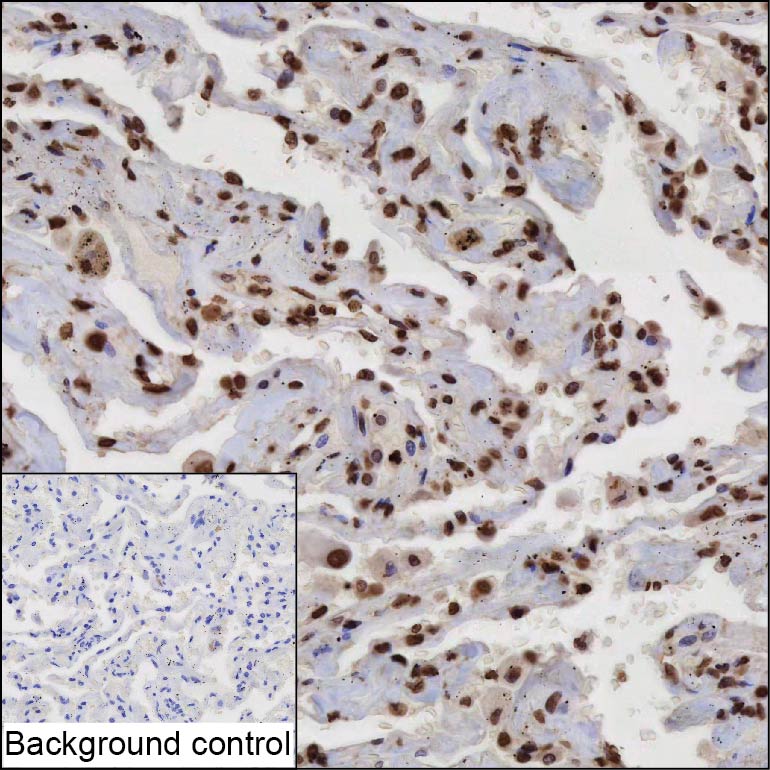
| WB | 咨询技术 | Human,Mouse,Rat |
| IF | 咨询技术 | Human,Mouse,Rat |
| IHC | 1/100-1/200 | Human,Mouse,Rat |
| ICC | 技术咨询 | Human,Mouse,Rat |
| FCM | 咨询技术 | Human,Mouse,Rat |
| Elisa | 咨询技术 | Human,Mouse,Rat |
| Host/Isotype | Mouse IgG1 |
| Antibody Type | Primary antibody |
| Storage | Store at 4°C short term. Aliquot and store at -20°C long term. Avoid freeze/thaw cycles. |
| Species Reactivity | Human |
| Immunogen | Purified recombinant fragment of human ZBTB17 |
| Formulation | Purified antibody in PBS with 0.05% sodium azide |
+ +
以下是3篇涉及ZBTB17抗体的文献示例(内容为模拟概括,实际文献需根据具体研究检索):
---
1. **文献名称**:*ZBTB17 modulates the senescence-associated secretory phenotype in human fibroblasts*
**作者**:Smith A, et al.
**摘要**:研究利用ZBTB17抗体进行免疫沉淀和ChIP-seq分析,发现ZBTB17通过调控p53通路影响细胞衰老相关分泌表型,为抗衰老机制提供新靶点。
---
2. **文献名称**:*ZBTB17 as a potential tumor suppressor in acute myeloid leukemia*
**作者**:Chen L, et al.
**摘要**:通过Western blot和免疫组化(使用ZBTB17抗体),验证ZBTB17在AML患者样本中低表达,其缺失促进白血病细胞增殖并抑制凋亡。
---
3. **文献名称**:*Genome-wide binding analysis of ZBTB17 reveals its role in mitochondrial metabolism regulation*
**作者**:Wang Y, et al.
**摘要**:结合ZBTB17抗体的染色质免疫共沉淀(ChIP)实验,发现ZBTB17直接靶向线粒体代谢相关基因,调控能量代谢平衡。
---
如需具体文献,建议通过PubMed或Google Scholar以“ZBTB17 antibody”为关键词检索,并筛选涉及实验方法(如Western blot、IHC、ChIP)的研究。
The ZBTB17 antibody is a crucial tool for studying the ZBTB17 protein (also known as MIZ1 or ZNF388), a member of the zinc finger and BTB domain-containing protein family. ZBTB17 functions as a transcription regulator, interacting with chromatin-modifying complexes and other proteins to modulate gene expression. It plays dual roles in cellular processes, acting as a tumor suppressor in some contexts by repressing oncogenes like MYC, while potentially promoting tumorigenesis in others through interactions with signaling pathways like TGF-β.
This antibody is widely used in techniques such as Western blotting, immunoprecipitation, chromatin immunoprecipitation (ChIP), and immunofluorescence to detect ZBTB17 expression levels, subcellular localization, and protein-protein/DNA interactions. Both monoclonal and polyclonal variants are available, typically raised in rabbit or mouse hosts. Validation data often include knockout cell lines or siRNA knockdown to confirm specificity.
Research involving ZBTB17 antibodies has advanced understanding of its roles in cancer, development, and immune regulation. However, challenges remain, including ensuring antibody specificity due to structural similarities within the ZBTB family. Ongoing studies focus on its tissue-specific functions and potential as a therapeutic target, emphasizing the antibody's continued importance in molecular and pathological investigations.
×